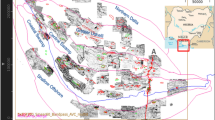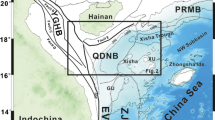Abstract
Both the shelf-edge trajectories and slope morphology are indicative of deep-water sedimentation, but previous studies are relatively independent from each other in the two dimensions. An integrated investigation can enhance the understanding of deep-water sedimentary systems and enrich reservoir prediction methods. Based on the bathymetry data and seismic data published, this study identified ten slope areas at the continental margin of East Africa and classified the clinoforms into three types: concave-up, sigmoidal and planar. Combined with the distribution of main modern rivers in East Africa, nine modern source-to-sink systems were identified and the catchment area is positively correlated with the size of the shelf-edge delta. It is found that the slope morphology of East Africa is closely related to the geological setting, sediment supply and sediment transport pathway in submarine canyon of passive continental margin. When the sediment supply is stable, the concave-up slopes are dominated by the river-associated and shelf-incising canyons and the sigmoidal slopes are determined by the headless canyons. There exists a strong coupling relationship between the shelf-edge trajectories and slope morphology. In general, concave-up slopes correspond to descending trend, flat and low-angle ascending trend shelf-edge trajectories and high-quality reservoirs developed on the basin floor under the influence of river-associated and shelf-incising canyons which have bright prospects for oil and gas exploration. Additionally, sigmoidal slopes usually correspond to descending trend, flat and low-angle ascending trend shelf-edge trajectories at times of relative sea-level fall and the reservoirs mostly developed on the upper slope under the influence of headless canyons. Moreover, the planar slopes correspond to high-angle ascending trend trajectories which are hardly potential for exploration. The coupling model built in this study will provide an insight for oil and gas exploration in deep-water areas with limited data and low exploration degree.
Similar content being viewed by others
References Cited
Adams, E. W., Schlager, W., 2000. Basic Types of Submarine Slope Curvature. Journal of Sedimentary Research, 70(4): 814–828. https://doi.org/10.1306/2dc4093a-0e47-11d7-8643000102c1865d
Allen, P. A., 2008. From Landscapes into Geological History. Nature, 451(7176): 274–276. https://doi.org/10.1038/nature06586
Bosellini, A., 1986. East Africa Continental Margins. Geology, 14(1): 76–78. https://doi.org/10.1130/0091-7613(1986)14<76:eacm>2.0.co;2
Burke, K., MacGregor, D. S., Cameron, N. R., 2003. Africa’s Petroleum Systems: Four Tectonic ‘Aces’ in the Past 600 Million Years. Geological Society, London, Special Publications, 207(1): 21–60. https://doi.org/10.1144/gsl.sp.2003.207.3
Carvajal, C., Steel, R., Petter, A., 2009. Sediment Supply: The Main Driver of Shelf-Margin Growth. Earth-Science Reviews, 96(4): 221–248. https://doi.org/10.1016/j.earscirev.2009.06.008
Castelino, J. A., Reichert, C., Jokat, W., 2017. Response of Cenozoic Turbidite System to Tectonic Activity and Sea-Level Change off the Zambezi Delta. Marine Geophysical Research, 38(3): 209–226. https://doi.org/10.1007/s11001-017-9305-8
Catuneanu, O., Abreu, V., Bhattacharya, J. P., et al., 2009. Towards the Standardization of Sequence Stratigraphy. Earth-Science Reviews, 92: 1–33. https://doi.org/10.1016/j.earscirev.2008.10.003
Chen, L., Yu, S., Hu, X., et al., 2018. Application from Combination of Slope Geometries and Shelf-Edge Trajectories to Find Large-Scale, Sand-Rich Deepwater Fan. Acta Sedimentologica Sinica, 36(1): 92–100 (in Chinese with English Abstract)
Chen, S., Steel, R. J., Olariu, C., 2016. Upper-Slope to Shelf-Edge Delta Architecture, Miocene Cruse Formation, Orinoco Shelf Margin, Trinidad. Journal of Sedimentary Research, 86(2): 87–106. https://doi.org/10.2110/jsr.2016.7
Covault, J. A., Fildani, A., Romans, B. W., et al., 2011. The Natural Range of Submarine Canyon-and-Channel Longitudinal Profiles. Geosphere, 7(2): 313–332. https://doi.org/10.1130/ges00610.1
Cruciani, F., Barchi, M. R., Koyi, H. A., et al., 2017. Kinematic Evolution of a Regional-Scale Gravity-Driven Deepwater Fold-and-Thrust Belt: The Lamu Basin Case-History (East Africa). Tectonophysics, 712–713: 30–44. https://doi.org/10.1016/j.tecto.2017.05.002
Cui, Z., 2015. Evaluation on Characteristics of Petroleum Geology and Exploration Potential of Coastal Key Basins in East Africa: [Dissertation]. Zhejiang University, Hangzhou (in Chinese with English Abstract)
Davison, I., Steel, I., 2017. Geology and Hydrocarbon Potential of the East African Continental Margin: A Review. Petroleum Geoscience, 24(1): 57–91. https://doi.org/10.1144/petgeo2017-028
Emery, K. O., 1980. Continental Margins—Classification and Petroleum Prospects. AAPG Bulletin, 64(3): 297–315
Farre, J. A., McGregor, B. A., Ryan, W. B. F., et al., 1983. Breaching the Shelfbreak: Passage from Youthful to Mature Phase in Submarine Canyon Evolution. In: Stanley, D. J., Moore, G. T., eds., The Shelf Break: Critical Interface on Continental Margins. Society of Economic Paleontologists and Mineralogists, Special Publication, 33: 25–39
Gong, C. L., Wang, Y. M., Pyles, D. R., et al., 2015a. Shelf-Edge Trajectories and Stratal Stacking Patterns: Their Sequence-Stratigraphic Significance and Relation to Styles of Deep-Water Sedimentation and Amount of Deep-Water Sandstone. AAPG Bulletin, 99(7): 1211–1243. https://doi.org/10.1306/01311513229
Gong, C. L., Wang, Y. M., Steel, R. J., et al., 2015b. Growth Styles of Shelf-Margin Clinoforms: Prediction of Sand- and Sediment-Budget Partitioning into and Across the Shelf. Journal of Sedimentary Research, 85(3): 209–229. https://doi.org/10.2110/jsr.2015.10
Harris, P. T., Whiteway, T., 2011. Global Distribution of Large Submarine Canyons: Geomorphic Differences between Active and Passive Continental Margins. Marine Geology, 285: 69–86. https://doi.org/10.1016/j.margeo.2011.05.008
Hedberg, H. D., 1970. Continental Margins from Viewpoint of Petroleum Geologist. AAPG Bulletin, 54(1): 3–43.
Helland-Hansen, W., Gjelberg, J. G., 1994. Conceptual Basis and Variability in Sequence Stratigraphy: A Different Perspective. Sedimentary Geology, 92(1/2): 31–52. https://doi.org/10.1016/0037-0738(94)90053-1
Helland-Hansen, W., Hampson, G. J., 2009. Trajectory Analysis: Concepts and Applications. Basin Research, 21(5): 454–483. https://doi.org/10.1111/j.1365-2117.2009.00425.x
Helland-Hansen, W., Martinsen, O. J., 1996. Shoreline Trajectories and Sequences: Description of Variable Depositional-Dip Scenarios. Journal of Sedimentary Research, 66(4): 670–688.
Henriksen, S., Hampson, G. J., Helland-Hansen, W., et al., 2009. Shelf Edge and Shoreline Trajectories, a Dynamic Approach to Stratigraphic Analysis. Basin Research, 21(5): 445–453. https://doi.org/10.1111/j.1365-2117.2009.00432.x
Henriksen, S., Helland-Hansen, W., Bullimore, S., 2011. Relationships between Shelf-Edge Trajectories and Sediment Dispersal along Depositional Dip and Strike: A Different Approach to Sequence Stratigraphy. Basin Research, 23(1): 3–21. https://doi.org/10.1111/j.1365-2117.2010.00463.x
Hicks, N., Green, A., 2016. Sedimentology and Depositional Architecture of a Submarine Delta-Fan Complex in the Durban Basin, South Africa. Marine and Petroleum Geology, 78: 390–404. https://doi.org/10.1016/j.marpetgeo.2016.09.032
Johannessen, E. P., Steel, R. J., 2005. Shelf-Margin Clinoforms and Prediction of Deepwater Sands. Basin Research, 17(4): 521–550. https://doi.org/10.1111/j.1365-2117.2005.00278.x
Klimke, J., Franke, D., Gaedicke, C., et al., 2016. How to Identify Oceanic Crust—Evidence for a Complex Break-Up in the Mozambique Channel, off East Africa. Tectonophysics, 693: 436–452. https://doi.org/10.1016/j.tecto.2015.10.012
Lawver, L., Coffin, M., Gahagan, L., 1992. The Mesozoic Break-up of Gondwana. First Indian Ocean Petroleum Seminar. Proceedings of the Indian Ocean, First Regional Seminar on Petroleum Exploration. 345–356
Lin, Z., Oguchi, T., Chen, Y. G., et al., 2009. Constant-Slope Alluvial Fans and Source Basins in Taiwan. Geology, 37(9): 787–790. https://doi.org/10.1130/g25675a.1
Liu, H., Meng, J., Zhang, Y. Z., Yang, L., 2018. Pliocene Seismic Stratigraphy and Deep-Water Sedimentation in the Qiongdongnan Basin, South China Sea: Source-to-Sink Systems and Hydrocarbon Accumulation Significance. Geological Journal, 54(1): 392–408. https://doi.org/10.1002/gj.3188
Liu, Z. F., Zhao, Y. L., Colin, C., et al., 2016. Source-to-Sink Transport Processes of Fluvial Sediments in the South China Sea. Earth-Science Reviews, 153: 238–273. https://doi.org/10.1016/j.earscirev.2015.08.005
Lü, C. L., Yao, Y. J., Gong, Y. H., et al., 2012. Deepwater Canyons Reworked by Bottom Currents: Sedimentary Evolution and Genetic Model. Journal of Earth Science, 23(5): 731–743. https://doi.org/10.1007/s12583-012-0280-3
Ma, B. J., Wu, S. G., Mi, L. J., et al., 2018. Mixed Carbonate-Siliciclastic Deposits in a Channel Complex in the Northern South China Sea. Journal of Earth Science, 29(3): 707–720. https://doi.org/10.1007/s12583-018-0830-4
Miller, K. G., 2005. The Phanerozoic Record of Global Sea-Level Change. Science, 310(5752): 1293–1298. https://doi.org/10.1126/science.1116412
Mo, W. L., Wu, C. D., Su, N., et al., 2019. Seismic Imaging of the Sedimentary System of the Upper Cretaceous Nenjiang Formation in the Northern Songliao Basin. Journal of Earth Science, 30(4): 788–798. https://doi.org/10.1007/s12583-017-0970-y
Nittrouer, C. A., Wright, L. D., 1994. Transport of Particles across Continental Shelves. Reviews of Geophysics, 32(1): 85–113. https://doi.org/10.1029/93rg02603
O’Grady, D. B., Syvitski, J. P. M., Pratson, L. F., et al., 2000. Categorizing the Morphologic Variability of Siliciclastic Passive Continental Margins. Geology, 28(3): 207–210. https://doi.org/10.1130/0091-7613(2000)28<207:ctmvos>2.0.co;2
Pechlivanidou, S., Cowie, P. A., Hannisdal, B., et al., 2017. Source-to-Sink Analysis in an Active Extensional Setting: Holocene Erosion and Deposition in the Sperchios Rift, Central Greece. Basin Research, 30(3): 522–543. https://doi.org/10.1111/bre.12263
Piper, D. J. W., Normark, W. R., 2009. Processes that Initiate Turbidity Currents and Their Influence on Turbidites: A Marine Geology Perspective. Journal of Sedimentary Research, 79(6): 347–362. https://doi.org/10.2110/jsr.2009.046
Plink-Björklund, P., Mellere, D., Steel, R. J., 2001. Turbidite Variability and Architecture of Sand-Prone, Deep-Water Slopes: Eocene Clinoforms in the Central Basin, Spitsbergen. Journal of Sedimentary Research, 71(6): 895–912. https://doi.org/10.1306/030501710895
Plink-Björklund, P., Steel, R., 2002. Sea-Level Fall below the Shelf Edge, without Basin-Floor Fans. Geology, 30(2): 115–118. https://doi.org/10.1130/0091-7613(2002)030<0115:slfbts>2.0.co;2
Ponte, J. P., Robin, C., Guillocheau, F., et al., 2019. The Zambezi Delta (Mozambique Channel, East Africa): High Resolution Dating Combining Bio-Orbital and Seismic Stratigraphies to Determine Climate (palaeoprecipitation) and Tectonic Controls on a Passive Margin. Marine and Petroleum Geology, 105: 293–312. https://doi.org/10.1016/j.marpetgeo.2018.07.017
Posamentier, H. W., Jervey, M. T., Vail, P. R., 1988. Eustatic Controls on Clasticdeposition: I. Conceptual Framework. In: Wilgus, C. K., Hastings, B. S., Ross, C. A., et al., eds., Sea-Level Changes: An Integrated Approach. Society of Economic Paleontologists and Mineralogists, Special Publication, 42: 109–124
Pratson, L. F., Coakley, B. J., 1996. A Model for the Headward Erosion of Submarine Canyons Induced by Downslope-Eroding Sediment Flows. Geological Society of America Bulletin, 108(2): 225–234. https://doi.org/10.1130/0016-7606(1996)108<0225:amfthe>2.3.co;2
Pratson, L. F., Nittrouer, C. A., Wiberg, P. L., 2007. Seascape Evolution on Clastic Continental Shelves and Slops. In: Nittrouer, C. A., ed., Continental Margin Sedimentation. Blackwell Publishing, Oxford. 340–380
Pratson, L. F., Ryan, W. B. F., Mountain, G. S., et al., 1994. Submarine Canyon Initiation by Downslope-Eroding Sediment Flows: Evidence in Late Cenozoic Strata on the New Jersey Continental Slope. Geological Society of America Bulletin, 106(3): 395–412. https://doi.org/10.1130/0016-7606(1994)106<0395:scibde>2.3.co;2
Rabinowitz, P. D., Coffin, M. F., Falvey, D., 1982. Salt Diapirs Bordering the Continental Margin of Northern Kenya and Southern Somalia. Science, 215(4533): 663–665. https://doi.org/10.1126/science.215.4533.663
Ross, W. C., Halliwell, B. A., May, J. A., et al., 1994. Slope Readjustment: A New Model for the Development of Submarine Fans and Aprons. Geology, 22(6): 511–514. https://doi.org/10.1130/0091-7613(1994)022<0511:sranmf>2.3.co;2
Salazar, M., 2014. The Impact of Shelf Margin Geometry and Tectonics on Shelf-to-Sink Sediment Dynamics and Resultant Basin Fill Architectures: [Dissertation]. University of Texas at Austin, Austin. 243
Salazar, M., Moscardelli, L., Wood, L., 2015. Utilising Clinoform Architecture to Understand the Drivers of Basin Margin Evolution: A Case Study in the Taranaki Basin, New Zealand. Basin Research, 28(6): 1–26. https://doi.org/10.1111/bre.12138
Salazar, M., Moscardelli, L., Wood, L., 2018. Two-Dimensional Stratigraphic Forward Modeling, Reconstructing High-Relief Clinoforms in the Northern Taranaki Basin. AAPG Bulletin, 102(12): 2409–2446. https://doi.org/10.1306/04241817235
Salman, G., Abdula, I., 1995. Development of the Mozambique and Ruvuma Sedimentary Basins, Offshore Mozambique. Sedimentary Geology, 96(1/2): 7–41. https://doi.org/10.1016/0037-0738(95)00125-r
Schlager, W., Adams, E. W., 2001. Model for the Sigmoidal Curvature of Submarine Slopes. Geology, 29(10): 883–886. https://doi.org/10.1130/0091-7613(2001)029<0883:mftsco>2.0.co;2
Shepard, F. P., 1981. Submarine Canyons: Multiple Causes and Long-Time Persistence. AAPG Bulletin, 65: 1062–1077.
Sømme, T. O., Helland-Hansen, W., Martinsen, O. J., et al., 2009. Relationships between Morphological and Sedimentological Parameters in Source-to-Sink Systems: A Basis for Predicting Semi-Quantitative Characteristics in Subsurface Systems. Basin Research, 21(4): 361–387. https://doi.org/10.1111/j.1365-2117.2009.00397.x
Steel, R., Olsen, T., 2002. Clinforms, Clinoform Trajectories and Deepwater Sands. In: Armentrout, J., ed., Sequence-Stratigraphic Models for Exploration and Production: Evolving Methodology, Emerging Models and Application Histories. GCSSEPM Proceedings 22nd Annual Conference, Tulsa. 367–381
Xu, S., Cong, F. Y., Hao, F., et al., 2018. Shelf-Edge Trajectory and Sediment Dispersal in a Lacustrine Setting: A Case Study from Qinnan Depression, Bohai Bay Basin, China. Marine and Petroleum Geology, 91: 562–575. https://doi.org/10.1016/j.marpetgeo.2018.01.027
Yu, H. S., Chang, E. T. Y., 2009. Links among Slope Morphology, Canyon Types and Tectonics on Passive and Active Margins in the Northernmost South China Sea. Journal of Earth Science, 20(1): 77–84. https://doi.org/10.1007/s12583-009-0008-1
Zhuo, H. T., Wang, Y. M., et al., 2018. Along-Strike Variability in Shelf-Margin Morphology and Accretion Pattern: An Example from the Northern Margin of the South China Sea. Basin Research, 31(3): 431–460. https://doi.org/10.1111/bre.12329
Acknowledgments
This research was financially funded by the National Natural Science Foundation of China (Nos. 41690134, 41821002, 41702155, 41690131). The final publication is available at Springer via https://doi.org/10.1007/s12583-020-1288-8.
Author information
Authors and Affiliations
Corresponding authors
Rights and permissions
About this article
Cite this article
Gao, M., Xu, S., Zhuo, H. et al. Coupling Relationship between Shelf-Edge Trajectories and Slope Morphology and Its Implications for Deep-Water Oil and Gas Exploration: A Case Study from the Passive Continental Margin, East Africa. J. Earth Sci. 31, 820–833 (2020). https://doi.org/10.1007/s12583-020-1288-8
Received:
Accepted:
Published:
Issue Date:
DOI: https://doi.org/10.1007/s12583-020-1288-8




